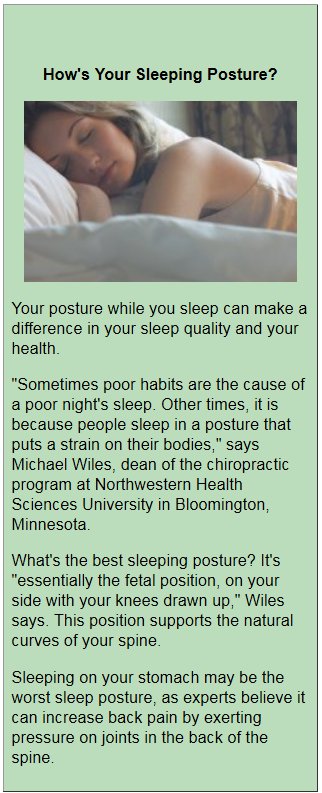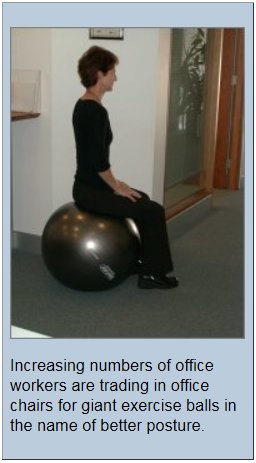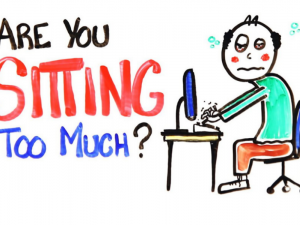Good Posture: The Important Health Benefits of -
and Keys to — Good Posture
©2015 Health Realizations, Inc. Update
"Sit up straight" and "Put your shoulders back" have been two of parents' favorite mantras for eons. And, as you may suspect, this is one case where mother and father really do know best. Having good posture (which does indeed incorporate sitting up straight and putting your shoulders back) is very important for your health.
 Look 10 Pounds Lighter AND More Confident
Look 10 Pounds Lighter AND More Confident
Many posture enthusiasts claim that the correct posture can instantly make you look 10 pounds lighter. Meanwhile, sitting or standing upright is key to looking confident and displaying that confidence to others.
With the correct posture you can look taller, slimmer and at ease with who you are. Compare that to someone who is slumped over in their work chair, slouching while they walk or hunched up in general, and the difference is obvious, at least from the outside.
Good Posture Affects Your Health from the Inside, Too
Having correct posture does not just affect the way you look to others; good posture will pass along many health benefits to you. Primarily, these health benefits occur because when your posture is correct, your muscles, organs, joints and bones are all where they're supposed to be. Stand or sit with improper posture, and unnecessary strain is inevitable.
"Strain issues, such as neck strain, low back pain or carpel tunnel syndrome are the most common effects of bad posture," says Dr. Kristine Fortuna, assistant professor for the department of orthopedic surgery at Temple University in Philadelphia. "These come from overuse of the muscle."
From the moment you adopt good posture (see below for how), you will feel an improvement in the way you carry yourself. However, as you make good posture the norm for you, you will also:
- Minimize your risk of many neck and back problems.
- Ensure that your joints don't wear abnormally, which can lead to arthritis.
- Be able to use your muscles more efficiently, because your bones and joints will be in the correct alignment. This will result in less fatigue, as your body will require less energy to move around.
- Prevent your spine from becoming fixed in an abnormal position. This can lead to constricted blood vessels and nerves, and problems with muscles, discs and joints, which can lead to headaches, fatigue and even problems with organs and breathing.
- Experience fewer strains and pains because you won't be overusing certain muscles and joints, nor putting unnecessary pressure on bones, joints and organs.
- Put less stress on the ligaments holding the spine's joints together.
 What Does "Bad" Posture Look Like?
What Does "Bad" Posture Look Like?While most of us can point out someone else with bad posture, we may not realize it in ourselves. And, even if we do, we may not do anything about it.
"People are aware of easy wrist stretches they can do at the desk. But they don't pay so much attention to their head's jetting forward and their rounded shoulders," said Doreen Frank, a physical therapist near Albany, New York. "I see lots of people with cervical thoracic strain and it's very much related to sustained poor posture at the computer."
Poor posture can come from many sources, including incorrect sitting and standing habits, obesity, pregnancy, an improperly arranged work environment, not enough flexibility and weak muscles. Signs that you may have poor posture include:
- Slouching and hunching your shoulders over
- Holding your head and neck forward and/or down
- Arching your lower back too much
- Commonly carrying a heavy purse or backpack on one side of your body
- Sitting on a wallet in your back pant's pocket
- "Holding" a phone receiver between your neck and shoulder
- Slumping forward while seated
While it will take time to adapt your body to naturally assume good posture (assuming you have strayed from it), you can use these tips to improve your posture today. With a little perseverance, your posture will be back on track (and, remember, modeling proper posture is essential to ensure that your kids have good posture, too!).
Good Posture Tips While Sitting
- Keep both feet flat on the floor (if your feet cannot reach the floor, adjust the chair or use a footrest)
- Align your back with the back of the chair
- Don't slouch or lean forward
- Adjust the chair so your knees are even with your hips, or slightly higher, and your arms are at a 75-90 degree angle at the elbows
- Keep your shoulders straight
- Choose an ergonomic office chair with good back support
- Get up often and stretch

- Keep your weight on the balls of your feet, not your heels
- Let your arms hang naturally by your side
- Keep feet about shoulder-width apart
- Don't lock your knees
- Keep your head level and in line with your neck and spine, not pushed forward
- Keep your shoulders upright and stand up straight
Sources
The Cleveland Clinic
Children Today
ZDNet News
Spine Health: Guidelines to Improve Posture
Bradenton Herald





